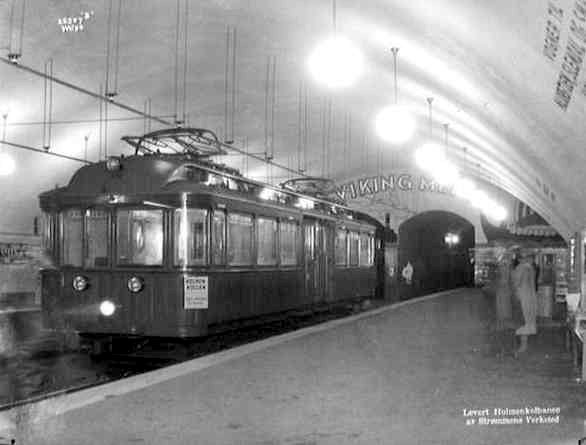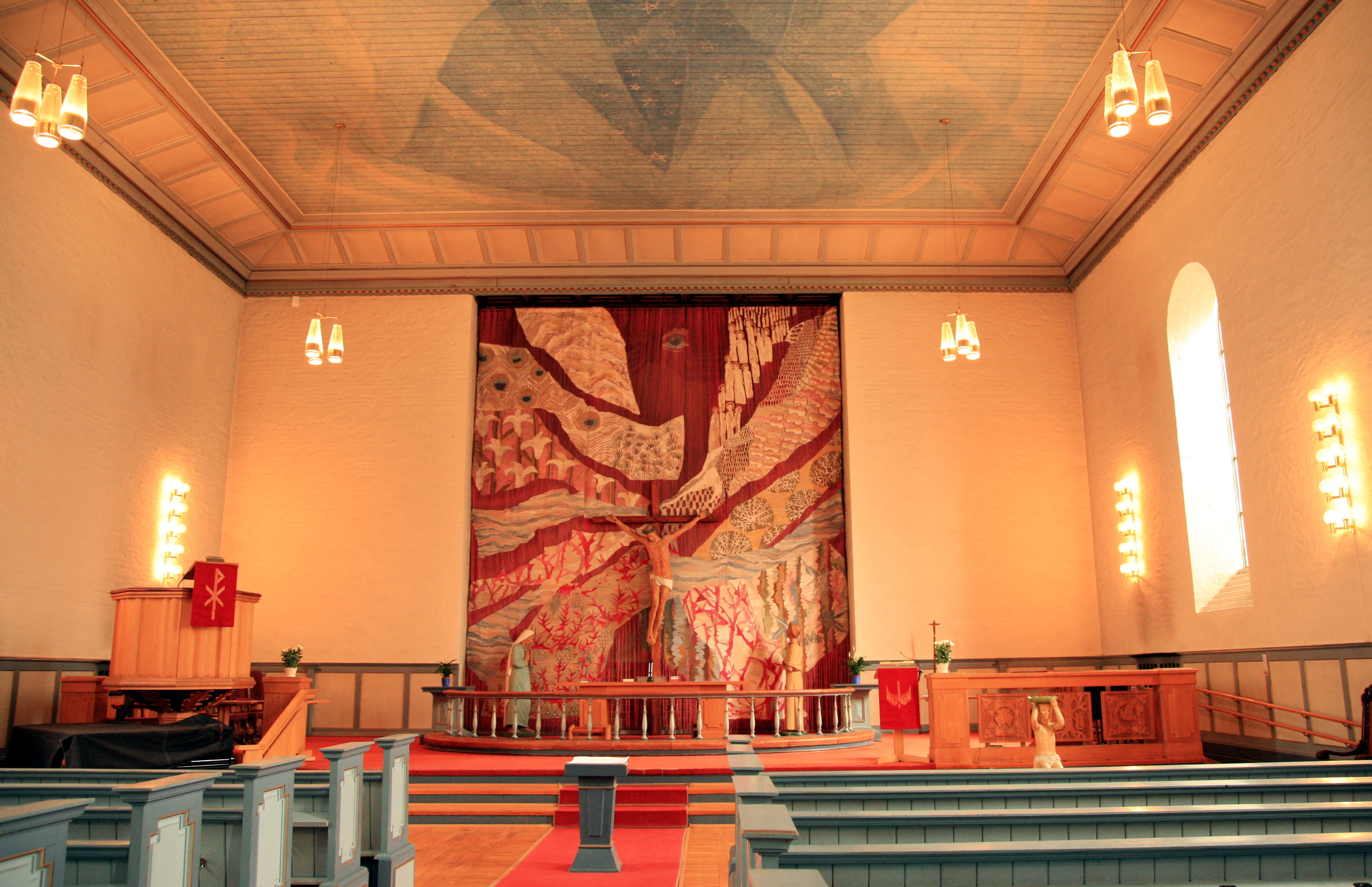|
Haugerud, Oslo
Haugerud is a neighborhood in the borough of Alna in Oslo, Norway. Its origin was a farm of the same name. It first had a private owner in 1670. Some of the land was parceled out in the early 1900s, and the rest of the land was bought by the municipality in 1947, and built up with apartment blocks in the late 1960s. Since 1970 it's served by the station Haugerud on the Oslo Metro. The local church opened in 1975, and the neighborhood also has a shopping mall. Haugerud Church Haugerud Church is a church center, consecrated in 1966. The church belongs to the Church of Norway. The altarpiece is a tapestry by Else Marie Jakobsen Else Marie Jakobsen (28 February 1927 – 12 December 2012) was a Norwegian designer and textile artist. Biography Jakobsen was born and raised in Kristiansand, Norway. She graduated from Norwegian National Academy of Craft and Art Industry (n .... The church bells are placed on the roof. The church has 600 seats in total. [...More Info...] [...Related Items...] OR: [Wikipedia] [Google] [Baidu] |
Haugerud T-bane 01
Haugerud is a Norwegian surname, derived from the Old Norse word ''haugr'' meaning hill, knoll, or mound. Related derivatives include the common Norwegian surnames Haugan, Hauge and Haugen. Haugerud can refer to: People *Johs Haugerud (1896–1971), Norwegian politician *Rita Haugerud (1919–2014), Norwegian politician * Howard E. Haugerud (1924–2019), American diplomat * Neil Sherman Haugerud (1930–2019), American politician Places *Haugerud, Oslo *Haugerud (station) Haugerud is the only non-underground station on the Furuset Line of the Oslo Metro. It is located in the Alna borough, between the stations of Tveita and Trosterud Trosterud is a neighborhood in Alna borough in Oslo, Norway Norway, o ..., Oslo {{disambiguation, surname Norwegian-language surnames ... [...More Info...] [...Related Items...] OR: [Wikipedia] [Google] [Baidu] |
Alna
Alna is a borough of the city of Oslo, Norway. It is named after the River Alna, which flows through it. The borough consists of the following neighborhoods: * Alnabru * Ellingsrud * Furuset * Haugerud * Hellerud * Lindeberg * Trosterud * Tveita Demographics As of January 1, 2020, there were 49,801 people living in the borough. Of these, 24,943 (50.1%) were male. There were 1,495 immigrants from Western countries and 24,943 from Non-Western countries (50%). The countries from where most immigrants originated were Pakistan (5,060), Turkey (1,500), Sri Lanka (1,161), the former Yugoslavia (1,078), and Somalia (756). There were 641 births in the borough in 2018, and 341 deaths. The same year 6,875 people moved into the borough, while 6,767 moved out. In 2018, the average gross income for the borough was NOK 394,000, somewhat lower than the average for the city of NOK 529,400. Politics As a borough of Oslo, Alna is governed by the city council of Oslo as well as its own boroug ... [...More Info...] [...Related Items...] OR: [Wikipedia] [Google] [Baidu] |
Oslo
Oslo ( , , or ; sma, Oslove) is the capital and most populous city of Norway. It constitutes both a county and a municipality. The municipality of Oslo had a population of in 2022, while the city's greater urban area had a population of in 2019, and the metropolitan area had an estimated population of in 2021. During the Viking Age the area was part of Viken. Oslo was founded as a city at the end of the Viking Age in 1040 under the name Ánslo, and established as a ''kaupstad'' or trading place in 1048 by Harald Hardrada. The city was elevated to a bishopric in 1070 and a capital under Haakon V of Norway around 1300. Personal unions with Denmark from 1397 to 1523 and again from 1536 to 1814 reduced its influence. After being destroyed by a fire in 1624, during the reign of King Christian IV, a new city was built closer to Akershus Fortress and named Christiania in honour of the king. It became a municipality ('' formannskapsdistrikt'') on 1 January 1838. The city fu ... [...More Info...] [...Related Items...] OR: [Wikipedia] [Google] [Baidu] |
Norway
Norway, officially the Kingdom of Norway, is a Nordic country in Northern Europe, the mainland territory of which comprises the western and northernmost portion of the Scandinavian Peninsula. The remote Arctic island of Jan Mayen and the archipelago of Svalbard also form part of Norway. Bouvet Island, located in the Subantarctic, is a dependency of Norway; it also lays claims to the Antarctic territories of Peter I Island and Queen Maud Land. The capital and largest city in Norway is Oslo. Norway has a total area of and had a population of 5,425,270 in January 2022. The country shares a long eastern border with Sweden at a length of . It is bordered by Finland and Russia to the northeast and the Skagerrak strait to the south, on the other side of which are Denmark and the United Kingdom. Norway has an extensive coastline, facing the North Atlantic Ocean and the Barents Sea. The maritime influence dominates Norway's climate, with mild lowland temperatures on the se ... [...More Info...] [...Related Items...] OR: [Wikipedia] [Google] [Baidu] |
Haugerud (station)
Haugerud is the only non-underground station on the Furuset Line of the Oslo Metro. It is located in the Alna borough, between the stations of Tveita and Trosterud Trosterud is a neighborhood in Alna borough in Oslo, Norway Norway, officially the Kingdom of Norway, is a Nordic country in Northern Europe, the mainland territory of which comprises the western and northernmost portion of the Scandin .... Like the area around many of the other stations on Furusetbanen, the area around Haugerud is a dense residential neighborhood with a number of tall apartment buildings. References External links Oslo Metro stations in Oslo Railway stations opened in 1970 1974 establishments in Norway {{Oslo-metro-stub ... [...More Info...] [...Related Items...] OR: [Wikipedia] [Google] [Baidu] |
Oslo Metro
The Oslo Metro ( no, Oslo T-bane or or simply ) is the rapid transit system of Oslo, Norway, operated by Sporveien T-banen on contract from the transit authority Ruter. The network consists of five lines that all run through the city centre, with a total length of , serving 101 stations of which 17 are underground or indoors. In addition to serving 14 out of the 15 boroughs of Oslo, two lines run to Kolsås and Østerås, in the neighboring municipality of Bærum. In 2016, the system had an annual ridership of 118 million. The first rapid transit line, the Holmenkollen Line, opened in 1898, with the branch Røa Line opening in 1912. It became the first Nordic underground rapid transit system in 1928, when the underground line to Nationaltheatret was opened. After 1993 trains ran under the city between the eastern and western networks in the Common Tunnel, followed by the 2006 opening of the Ring Line. All the trains are operated with MX3000 stock. These replaced the older T100 ... [...More Info...] [...Related Items...] OR: [Wikipedia] [Google] [Baidu] |
Haugerud Kirke Nord
Haugerud is a Norwegian surname, derived from the Old Norse word ''haugr'' meaning hill, knoll, or mound. Related derivatives include the common Norwegian surnames Haugan, Hauge and Haugen. Haugerud can refer to: People *Johs Haugerud (1896–1971), Norwegian politician *Rita Haugerud (1919–2014), Norwegian politician * Howard E. Haugerud (1924–2019), American diplomat * Neil Sherman Haugerud (1930–2019), American politician Places *Haugerud, Oslo *Haugerud (station) Haugerud is the only non-underground station on the Furuset Line of the Oslo Metro. It is located in the Alna borough, between the stations of Tveita and Trosterud Trosterud is a neighborhood in Alna borough in Oslo, Norway Norway, o ..., Oslo {{disambiguation, surname Norwegian-language surnames ... [...More Info...] [...Related Items...] OR: [Wikipedia] [Google] [Baidu] |
Church Of Norway
The Church of Norway ( nb, Den norske kirke, nn, Den norske kyrkja, se, Norgga girku, sma, Nöörjen gærhkoe) is an evangelical Lutheran denomination of Protestant Christianity and by far the largest Christian church in Norway. The church became the state church of Norway around 1020, and was established as a separate church intimately integrated with the state as a result of the Lutheran reformation in Denmark–Norway which broke ties with the Holy See in 1536–1537; the King of Norway was the church's head from 1537 to 2012. Historically the church was one of the main instruments of royal power and official authority, and an important part of the state administration; local government was based on the church's parishes with significant official responsibility held by the parish priest. In the 19th and 20th centuries it gradually ceded most administrative functions to the secular civil service. The modern Constitution of Norway describes the church as the country's "peo ... [...More Info...] [...Related Items...] OR: [Wikipedia] [Google] [Baidu] |
Altarpiece
An altarpiece is an artwork such as a painting, sculpture or relief representing a religious subject made for placing at the back of or behind the altar of a Christian church. Though most commonly used for a single work of art such as a painting or sculpture, or a set of them, the word can also be used of the whole ensemble behind an altar, otherwise known as a reredos, including what is often an elaborate frame for the central image or images. Altarpieces were one of the most important products of Christian art especially from the late Middle Ages to the era of the Counter-Reformation. Many altarpieces have been removed from their church settings, and often from their elaborate sculpted frameworks, and are displayed as more simply framed paintings in museums and elsewhere. History Origins and early development Altarpieces seem to have begun to be used during the 11th century, with the possible exception of a few earlier examples. The reasons and forces that led to the developme ... [...More Info...] [...Related Items...] OR: [Wikipedia] [Google] [Baidu] |
Tapestry
Tapestry is a form of textile art, traditionally woven by hand on a loom. Tapestry is weft-faced weaving, in which all the warp threads are hidden in the completed work, unlike most woven textiles, where both the warp and the weft threads may be visible. In tapestry weaving, weft yarns are typically discontinuous; the artisan interlaces each coloured weft back and forth in its own small pattern area. It is a plain weft-faced weave having weft threads of different colours worked over portions of the warp to form the design. Tapestry is relatively fragile, and difficult to make, so most historical pieces are intended to hang vertically on a wall (or sometimes in tents), or sometimes horizontally over a piece of furniture such as a table or bed. Some periods made smaller pieces, often long and narrow and used as borders for other textiles. European tapestries are normally made to be seen only from one side, and often have a plain lining added on the back. However, other tradit ... [...More Info...] [...Related Items...] OR: [Wikipedia] [Google] [Baidu] |
Else Marie Jakobsen
Else Marie Jakobsen (28 February 1927 – 12 December 2012) was a Norwegian designer and textile artist. Biography Jakobsen was born and raised in Kristiansand, Norway. She graduated from Norwegian National Academy of Craft and Art Industry (now Oslo National Academy of the Arts) in 1951. She also studied at a Gobelin tapestry workshop at Uitgeverij In de Knipscheer in the Netherlands during 1950. She was from 1951, both a designer and an artist in the textile industries, At the same time she began to make tapestries. Her debut exhibition was held at the Artists' Association (''Kunstnerforbundet'') at Oslo in 1966. In addition, she was active as a speaker across Norway and in other countries as well. As a textile artist, she won the decoration competition for the University of Bergen science building (90 square meters) as well as the Erkebispegården, Trondheim (30 square meters) and Kristiansand District Court. Else Marie Jakobsen is particularly known for her work on alta ... [...More Info...] [...Related Items...] OR: [Wikipedia] [Google] [Baidu] |





